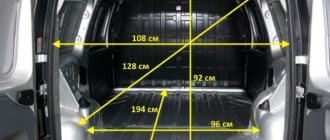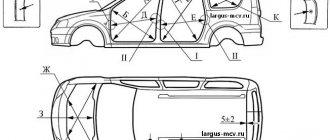Let's look at the technical parameters of Largus using the example of Largus Cross 5 seats, the release of which has become a successful solution for driving on Russian roads. For more than two years, Lada Largus has occupied a strong position among station wagons on the Russian market. The domestically assembled car, created on the basis of the B0 platform of the French Renault Logan, attracts consumers with its simplicity, reliability and spaciousness. There is also a modification of this model for 7 passenger seats. Despite the fact that this model has been on the market for quite a long time, demand remains high. For potential buyers, this article will discuss the technical characteristics of the Lada Largus 5 seats.
"insides" of the car
The Lada-Largus van is equipped with the same gasoline engines as the station wagon of the same name - these are in-line fours with a displacement of 1.6 liters:
- 8-valve engine that is capable of developing 87 hp. With. at 5100 rpm.
- 16-valve engine with a potential of 106 hp. With. at 5800 rpm.
As standard, the car is equipped with a 5-speed manual transmission and a front-wheel drive transmission. From 0 to 100 km/h the Lada-Largus van picks up speed in 14-15.4 seconds to 158-165 km/h. In the combined cycle, the car “eats” 7.9-8.2 liters of fuel for every hundred kilometers.
The van is built on the front-wheel drive B0 platform. The actual size of the body of the Lada-Largus van and the dimensions of the entire structure make the car practical and at the same time visually compact.
Unfasten the partition or part of it
The partition separating the body and the cabin consists of two halves. They can be removed separately. Both parts are screwed to the body with screws designed for a 13mm key size. Of course, you need a socket wrench.
Screws 1 were hidden under the casing
The four screws on the left and right are located on the cab side. And to unscrew them, remove the casing.
All actions with cladding
The left part of the septum is removed after the right. To remove only the left half, first remove both, and then mount the right sash back. Based on this, immediately decide where you will remove the trim - only on the right or on both sides.
The volume of the body on the Lada Largus van cannot be greatly increased, even if the partition is completely removed. But without the partition, by removing the seat, it will be possible to transport loads 3 meters long.
So, let's start dismantling the trim: you need to remove the seat belt (key “17”), and then unscrew one self-tapping screw. A Torx T20 wrench is suitable for the self-tapping screw.
Two parts “1” prevent the removal of casing “2”
It is necessary to unscrew all the parts numbered 1. And the casing will have to be removed, overcoming the resistance of the clamps.
Removing the partition
First, unscrew the four screws shown at the beginning of the chapter (key “13”). Then with the same key they go into the body.
All fasteners are the same
As you can see, both halves are held on three sides: top, bottom, middle. The number of screws will be as follows: four at the top and bottom, five at the seam between the sashes. Work order:
- Completely unscrew the four screws on top;
- While holding the nuts on the seam, unscrew the screws from the cabin side;
- The lower screws are unscrewed 2-3 turns. Then all parts are disengaged.
Asceticism
The only obvious drawback of the Lada-Largus is its deliberate asceticism. The interior of the car has not changed at all since the creation of the first generation Renault Logan. This model contains only the bare minimum.
But many car enthusiasts today want to see some additional frills in their cars, such as heated seats and mirrors, modern multimedia, and electronic assistants.
The impressive dimensions of the Lada-Largus van, heated front seats, a single-din radio, an ABS system and rear parking sensors are all that are included as standard. The car is equipped with only two airbags and manual air conditioning.
Many cars are created with the aim of setting speed records and most of them captivate with their stylish and original design.
The Lada-Largus van, with a body size that allows it to transport large items, was invented specifically for work and family. The car will be able to drive where sports cars with low clearance cannot move.
At the same time, drivers will look at the Lada-Largus with real love, because only a working car is considered truly beautiful.
Cheap to operate
The affordability of maintaining a car consists of two main factors: the car should not require large financial investments, and the price of spare parts and consumables should be moderate. With both factors, the Lada-Largus van with a larger-than-average cargo compartment is in perfect order. Engines from , even if an unscheduled breakdown occurs, can be brought back to life quite realistically at low cost. The same applies to other components and systems of the car.
The low cost of spare parts is also explained by their widespread availability. Car brands such as Renault Logan, Sandero, Duster and Kaptur, Nissan Almera and Xray are produced on the B0 platform with many parts. The annual total circulation of these cars is about 200,000 copies on the Russian market alone. It is quite clear that spare parts for them are produced in large quantities, which helps to save a lot.
Dimensions of Largus van
For this class of car they are worthy, what are the dimensions of the cargo compartment? The length of the station wagon “grew” to 4.44 m, and the width was 1.7 m. The height will not irritate tall drivers, because 1.6 m is quite enough for a comfortable fit in the cabin.
The wheelbase turned out to be quite competitive - 2.9 m. And we will also touch on such an important indicator for domestic roads as ground clearance. 145 mm of clearance allows the car to confidently overcome a lot of obstacles that have settled on Russian roads. These are the dimensions of the cargo compartment of the Largus van.
Oil change on Largus 16 valve
Largus trunk volume
Changing the oil in the Largus gearbox
What is the carrying capacity of the Lada-Largus: comparison with competitors
The certified carrying capacity of all modifications of the Lada Largus, calculated as the difference between the curb and gross weights of the vehicle, has the following values:
- 445 kg for a 5-seater station wagon;
- 480 kg for the 7-seater version and for Largus Cross;
- 750 kg for a van.
Undoubtedly, the characteristics are impressive for a B-class family car, and the Largus van is comparable to the capabilities of representatives of the commercial LCV segment, such as the GAZ-2752 Sobol.
However, considering cargo capabilities only in terms of payload is not entirely correct. After all, humanity invented trucks to transport cinder blocks and floor slabs. And for a typical station wagon owner, the most important thing is to answer the question of whether he can carry ten packs of insulation at a time, and whether a two-meter refrigerator will fit into the cabin.
Therefore, it is possible to more objectively assess the cargo capabilities of the Lada Largus based on the volume of the luggage compartment and its dimensions (depth, width and height).
In addition, we should not forget about the price component: the Audi allroad station wagon with a three-liter engine has a comparable maximum load capacity of 500 kg, but the cost is equal to 8.5 Largus.
Foreign cars with comparable carrying capacity
If it is difficult to find a car with similar characteristics among ordinary station wagons, you should turn to neighboring classes.
5 and 7-seater options with a spacious trunk are typical for the MPV class, which unites minivans and high-capacity station wagons. Among the typical representatives are Renault Kangoo, Peugeot Partner, Fiat Doblo, Skoda Roomster, Volkswagen Caddy.
Without focusing on the significantly higher cost of these vehicles, we will conduct a comparative analysis of their cargo capabilities:
- Renault Kangoo is available as a 5-seater minivan with a payload of 451 kg and a van with a payload of 592 kg. Luggage compartment volume ranges from 660 liters as standard to 1,524 liters for vans and minivans with the rear seats folded down.
- The Skoda Roomster is designed for 5 seats and can accommodate from 450 to 1555 liters of luggage weighing 455 kg.
- Peugeot Partner in minivan format (5 seats) with a luggage compartment of up to 2800 liters and in a van modification of up to 2830 liters can carry up to 600 kg of luggage.
- Volkswagen Caddy for 5 or 7 passengers takes up to 665 kg of cargo in the trunk. The volume of the compartment, depending on the configuration of the seats, ranges from 750 to 3300 liters. The Caddy Maxi van with an extended wheelbase has a luggage compartment volume of 4.2 m3.
Lada Largus cargo van
In 2022, the domestic car market was replenished with a new universal model Lada Largus. This product from AvtoVAZ immediately fell in love with a wide mass of fans who value unpretentiousness and practicality in a car. Two years earlier, the prototype was first presented to the general public, and the cargo van version was positioned as a commercial option.
When compared with foreign analogues, the Russian station wagon has a significant advantage – a lower price. According to the manufacturer, the quality indicators of the Lada Largus can compete on equal terms with the advantages of such popular foreign cars as Citroen Berlingo or Renault Kangoo in cargo version.
Lada Largus van technical specifications
Van LADA Largus
The Largus van, built on the basis of the European quality standards of the Reno company, provides not only safety and reliability when transporting goods, but also convenience, comfort, as well as safety of driving in an emergency situation on the road, in which it is helped by:
- anti-lock braking system that meets modern quality standards;
- reinforced suspension and brakes compared to the European analogue Logan MCV, built taking into account the condition of domestic roads;
- reinforced body frame that effectively prevents itself from being crushed during a frontal impact;
- airbags are located in the front and side areas; in the event of a collision, both the driver and the person in the passenger seat will be protected;
- three-point seat belts;
- other nice little things like a seat belt indicator, an adjustable steering column, a high ceiling and an adjustable seat.
New Lada: Catalog of spare parts for Lada Vesta.
Catalog 2015 (Lada Vesta) The Largus van is pleased with the size of its cargo compartment. The declared volume of space for luggage and cargo is as much as 2540 liters. In fact, this is:
- 194 cm in length;
- 92 cm in height;
- loading width 108 cm;
- in the area of the wheel arches it decreases to 96 cm.
The trunk is also notable for the fact that it has clever mounting points in the bottom of the car (6 pieces in total) for securing luggage with belts or a rope. Rubberized walls and a rubber mat Largus van guarantee the safety of cargo during transportation. The driver's compartment with luggage compartment is also divided by a partition.
Cargo compartment
We have to agree, the dimensions of the cargo compartment on the Lada Largus van are quite decent, and here it would not be amiss to think about how to effectively store and unload small luggage from it. Do not completely disassemble the entire luggage compartment for the sake of things stored in its rear part. Here, too, everything is very well thought out, because the Largus van is equipped with three wide cargo doors: a double one in the rear and another pair on the sides. We must pay tribute - it is very convenient and practical.
On the Lada Largus, the cargo compartment pleases not only with its spaciousness, but also with the permissible weight of transported luggage. Still, the distinctive feature of the Lada Largus is its carrying capacity.
The van, if measured in 50 kg bags of cement, can easily transport up to 16 pieces. It is difficult to imagine other utensils that can overload the luggage compartment by more than 800 kg.
In other matters, the car can withstand loads of up to a ton, but in this case the carrying capacity of the Largus van goes beyond the established limits.
dimensions and dimensions in centimeters, length, width
LADA Largus has long won the sympathy of Russian car enthusiasts
Drivers often pay attention to the large trunk volume of the Lada Largus, which is considered the main advantage of this car. Domestic cars also cope well with another task - providing inexpensive and comfortable travel on modern roads
These two aspects and the ability to accommodate a large number of passengers allowed the car, produced at the Russian AvtoVAZ, to become a popular model in the CIS countries.
The dimensions of the Largus trunk depend on the body variation, it can be:
Each car variation has its own luggage compartment volume. In a station wagon designed for 5 seats, the volume of this compartment is 700 liters. But the owner of this model can transport a large load. In the Lada Largus station wagon, the trunk volume can be increased to 1500–1800 liters by removing the second row of seats - a three-seater sofa. With the seats folded down, the station wagon's luggage compartment volume increases to 2,350 liters.
The Largus van has the largest trunk dimensions. In this variation of the car there is no back row of seats, and sometimes even two, and the body is elongated. Officially, the van's trunk capacity is 2,500 liters. The main task of the model is to transport goods, so there are no additional components or elements inside the body.
The van has a reinforced suspension, as this model is designed for transporting large cargo. Station wagons do not have this option.
Cross
The smallest trunk size is in the Largus minivan, designed for 7 seats. The Largus Cross trunk reaches a volume of 200 liters. The manufacturer helped car owners by allowing them to increase the volume of the luggage compartment in liters to 1600–1800, for which two rows of seats should be removed.
The seven-seater version (minivan) has the most “modest” luggage compartment. But the manufacturer met his loyal customer halfway and endowed this modification with a simple secret: it is also possible to increase the luggage space to the same 1600–1800 liters by performing an identical operation to dismantle the stern seats. To do this, you will need to remove two planting rows.
Of course, neither a station wagon nor a minivan are designed to transport large loads, but if necessary, they will cope with this task perfectly.
Luggage compartment dimensions
Based on the above, we can conclude that the dimensions of the luggage compartment of any version of the Lada Largus are quite impressive. The general dimensions of this compartment for the models are as follows:
- opening height is 920 mm;
- the opening width is 980 mm;
- the height of the luggage compartment to the ceiling is from 870 to 930 mm for universal models and up to 1000 mm for a van;
- trunk length is 480–1570 mm for station wagons up to the 3rd and 2nd row of seats;
- The length of the van's luggage compartment is 1800 mm to the dividing wall;
- luggage compartment width – 1000–1450 mm.
Advantages and disadvantages
To make the right decision, you need to study not only the advantages, but also the disadvantages of the model. The owners, who have extensive experience in operating Largus, found one drawback. The car manufacturer did not adjust the interior of the station wagons in such a way that their owners would have the opportunity to transport large loads. If the driver nevertheless decided to load a large object into his car, then the cargo often caused damage to the interior.
Otherwise, Lada Largus owners are satisfied with everything in their cars. Among the advantages of a Russian car are the following:
- ease of loading;
- optimal dimensions;
- the ability to increase trunk capacity by removing the seats;
- high load capacity;
- possibility of modernization.
Drivers universally note the practicality and convenience of the LADA Largus trunk. Its size is quite enough to demonstrate the functionality of a domestic car, which allowed it to become a leader among its closest competitors. The manufacturer managed to competently and rationally approach the arrangement of the body space, which allows Largus to successfully transport large objects and indicates the enviable carrying capacity of the model.
Lada Largus is recommended for those drivers who want to get a car with the best consumer properties and technical characteristics.
Largus van cargo compartment dimensions and load capacity
The trunk volume of the Largus Station wagon directly depends on the number of installed rows of seats. In liters this will be respectively: 135/560/2350
Load capacity may vary slightly depending on modification. Average - about 550 kg. (more precisely in the characteristics)
Dimensions of the cabin and luggage compartment (for transportation of long cargo)
The length of the cabin from the trunk door to the windshield in the area of the dashboard is 3 m. 14 cm. Distance from the trunk door to the dashboard
2 m. 70 cm. The diagonal size of the cabin (from corner to corner) is 3 m. 24 cm. The width of the cabin behind the front seats is 1 m. 43 cm. The width of the cabin at the shoulder level of the third row passengers is about 1 m. 29 cm. . Distance from the threshold of the trunk door to the folded rear seat of the second row (it stands upright)
1.5 m. (max 1.66 m.) With the rear seat completely removed, the distance will increase by another 20 cm.
To transport long items, fold down the backrest of the second row and recline the backrest of the front passenger seat onto it. An extra-long weight can be rested with one end on the instrument panel, just be sure to place something soft so as not to scratch the plastic. And secure the length with a seat belt.
L1 - 910-1120mm, L2 - 590-790mm, H - 1310mm, H1 - 1080mm, H2 - 1020mm, B1 - 1380mm, B2 - 1405mm, L3 min/max - 1250/1700mm, B3 min - 1000mm, H3 - 475/ 1050mm, H4 - 920mm, Vbag. - 488 l.
Approximate internal dimensions of the luggage compartment Largus Station wagon
Internal dimensions of Largus Van
The internal volume of the serial Largus van is 2.54 m³.
Dimensions of the trunk door opening: height 92 cm, width 96 cm. Diagonal from top corner to wheel arch: 128 cm. Internal distance between wheel arches 96 cm.
Distance from the edge of the trunk to the partition: 194 cm.
Dimensions of doorways, trunk, hood, etc.
Even when I was choosing a car, I tried to find the dimensions, but nothing was written) Many people still ask me questions.
So let's blog.
The length at the bottom is 187cm. Smaller on top, because... The cabin is separated from the body by a “7” shaped partition.
The height of the opening at the back is 92cm. Again, then there is more space, after the opening there is about a meter there.
The opening width is 108cm.
The width of the floor between the wheel arches is 98 cm.
The width of the floor after the arches (the actual width of the compartment) is 134 cm.
The width of the side door opening is around 61cm.
Takes a ton with a bang)
Sofa? No problem!
Largus everyone, pasans))
z.y. We are expecting slippers from Japan) tires 215/40/18 are already lying around and waiting in the wings!
Volume and dimensions of the luggage compartment of the Largus family
So, we present the contenders for the championship title in the category “The most spacious trunk for 500 thousand rubles”:
New Lada: New Lada Largus Wagon 5 seats: configurations and prices - buy Lada Largus Wagon 5 seats in Moscow on credit and Trade In
The 5-seater Lada Largus with a load capacity of up to 445 kg, according to official information from AvtoVAZ, has a luggage compartment with a volume of 560 liters. With the rear row seats folded down, 2,350 liters of usable space are available to accommodate cargo.
The linear dimensions of the compartment have the following values:
- Trunk length 90 cm or 174 cm (to the level of the backs of the front seats);
- Actual compartment width 134 cm;
- The height of the rear door opening is 92 cm.
In the 7-seater modification of the Lada Largus, the load capacity declared by the manufacturer is increased by 35 kg compared to its 5-seater brother due to the reinforced suspension. The trunk is designed for 135 liters of cargo. By folding the backrests of the third row of seats, you can increase the luggage volume to 560 liters. A maximum capacity of 2,350 liters is provided when all rows of seats except the first are folded down. The Lada Largus Cross also shows similar load capacity parameters.
The following video describes the procedure for dismantling the right-side seats for transporting cargo over two meters long:
Warning! Stowing cargo above the openings of the side and rear windows seriously impairs visibility. Be careful when driving so as not to get into an emergency situation.
Another unique modification of Largus is a van, suitable for transporting small quantities of various goods or for use as a traveling vehicle for repairmen, builders and other technical services.
The Largus cargo van has a load capacity of up to 750 kg. The length of the luggage compartment is 194 cm at floor level; at roof level the size is reduced due to the shape of the cabin partition. The floor distance between the rear wheel arches is 96 cm, the actual width of the cargo compartment is 134 cm. The width of the side door opening is about 61 cm.
Reminder! Unless absolutely necessary, you should not exceed the maximum load capacity established by the manufacturer, even if the luggage compartment space allows it. In this case, there is a high probability of damage to the vehicle’s suspension elements.
Among the products of the Russian automobile industry in the station wagon body are the Lada Priora and Lada Kalina 2 cars.
For the Lada Kalina 2 (VAZ 2194), the name “station wagon” rather informs about the body type than indicates serious load-carrying capacity. The luggage compartment capacity is 355 liters (with the rear row of seats folded - 670 liters), which is comparable to that of full-size sedans. Based on the dimensions of the Kalina platform, the linear dimensions of the luggage compartment are also very modest.
Lada Priora (VAZ 2171) is a five-seat front-wheel drive station wagon capable of carrying up to 400 kg of payload in a 444-liter trunk (excluding the weight of the driver and passengers).
With the rear seats folded down, the cabin can accommodate 777 liters of cargo (up to the level of the window openings).
The depth of the trunk is 98.5 cm (164 cm with the seats folded), the height from the trunk floor to the roof of the cabin is 84.5 cm, and the maximum width of the luggage compartment is 150 cm. The loading opening is limited by the tailgate, which opens upward.
The Ukrainian clone of Lada 2111, the Bogdan station wagon, has similar load-carrying capacity indicators. In addition, the design of this model has become morally and physically outdated more than 20 years from the start of serial production.
All these options can, with some stretch, be considered as cars with characteristics close to the 5-seater Largus. And if it is necessary to accommodate 7 people with luggage in the car, in addition to the Lada Largus, domestic manufacturers can only offer shortened versions of Gorky’s GAZelles.
To compare with the Largus van, among Russian cars we can mention pickups from the Samara “VAZINTERSERVIS”, such as the LADA Granta VIS-234900 with a 3900-liter van and a load capacity of up to 720 kg. However, this is still a remake (albeit a factory one), and prices for VIS start at 600 thousand rubles.
Station wagon body and dimensions
The body of this car is not from VAZ. The seats of Lada Largus 5 are a modified Largus model, which in turn received the appearance of the French car Renault Logan. This decision was made due to the fact that Logan left for Russia in recent years. Therefore, the B0 platform, already well known to domestic consumers, was chosen as the basis for creating Largus. Lada Largus Cross 5 seats - an upgraded version with larger wheels for greater off-road capability than off-road capability.
The cross version has the following dimensions:
- 4.47 m long;
- 1.756 m wide;
- height 1682 m;
- distance 0 17 m;
- the front wheel track is 0.05 m shorter than the rear (1461 m versus 1466 m);
- trunk volume 560 l.
The car is front-wheel drive, that is, the front wheel pair is the main one. The engine is located at the front through the hood. The body design is classic, proven over the years by Renault. The lines are straight, restrained, there are sharp transitions from one element of the exterior to another.
Ground clearance has been increased compared to the standard station wagon to provide better off-road performance. The trunk of the 5-seater Largus station wagon has an impressive volume of 560 liters without folding the rear seats. When the passenger seats are folded, the trunk becomes many times larger and makes the Largus a full-fledged van. The trunk mat of Lada Largus is not included.
The empty Largus weighs about 1.3 tons, and the total weight is about 1.75 tons.
About the car
With impressive cargo compartment dimensions, the Lada-Largus van is a practical domestic vehicle based on the B0 platform.
By its nature, this is a Renault Logan Van, released in 2006, on which specialists simply changed the emblem and performed some modifications.
The Lada-Largus is perceived as a workhorse, which will appeal to both avid lovers of trips to the countryside and entrepreneurs who specialize in small cargo transportation.
The practicality of the car is perfectly combined with a high level of comfort. The Lada-Largus van has a modern air conditioner and audio system, heated front seats, central locking, electric windows and other useful options that are a significant contribution to the profitability of the business. This is explained by the fact that driver comfort affects the success of transportation.
In addition to the above advantages, Lada-Largus has the following options:
- Power steering.
- The glove box is large.
- Pockets in the front doors for storing small items.
- The center console is ergonomic.
- A lighting point is integrated into the luggage compartment.
The car has high cross-country ability: ground clearance without load is 18.1 cm, with full load - 14.5 cm. The gear ratios in the gearbox are selected specifically for the cargo model.
New Lada: Viburnum wheel and tire sizes
Technical parameters of Lada Largus
Lada Largus does not have diesel versions in its engine line and is content with only gasoline units. In terms of technical capabilities, the manufacturer sought to make its car, first of all, accessible to a wide range of social groups.
Motors are available to choose from, both 8-valve and 16-valve versions of cylinder heads. The volume of the units is identical - 1.6 liters. Power reaches 87 “forces” and 105 “horses” depending on the number of valves.
The layout of the Lada Largus car is front-wheel drive. There is also an independent suspension design at the front, and at the rear the chassis has a semi-independent mechanism, where the torsion beam acts as the main element.
All wheels are equipped with disc brakes.
The trunk can accommodate cargo equivalent to a volume of 2540 liters.
The fuel tank can hold a maximum of 50 liters. Touching upon fuel consumption per traditional hundred kilometers, we note that this important indicator varies between 6-11 liters. This range width is influenced by the driving style and conditions of use of the car.
Technical characteristics of the Lada Largus van depending on the configuration
It is very noteworthy that the car provides a number of additional options. So, for example, a Largus van can be equipped with one of two gasoline engines produced by Reno. The following options are available for you to choose from:
- K4M. 16-valve, develops power up to 102 hp;
- K7M. 8-valve, develops power up to 87 hp.
Moreover, the simplest configuration of the Largus van, equipped with a K4M power unit, will cost the buyer 485,000 rubles. For a more advanced engine and additional options along with it, the buyer will have to pay 545,400 rubles (from which the technical characteristics of the Largus van will be slightly different in terms of dynamics and comfort). The “red” price of the Luxury vehicle assembly additionally includes:
- passenger airbag with the ability to turn it off;
- fog lights;
- passenger sun visor with built-in mirror;
- a whole host of additional features of the Largus van for maximum driving comfort: height-adjustable seat belts, central locking with remote control, power windows for the driver's compartment doors, heated seats, climate control, an advanced audio system and 2 speakers for it.
Renault 8 valve engine
And yet, it is the carrying capacity of the Largus van that remains its main trump card, not to mention the spaciousness and thoughtfulness of the luggage compartment. That is why it is worth recommending the car to a wide mass of consumers. For the offered price, you can hardly find something better on the domestic market.
The Largus Lada van can perhaps be considered the most adaptable domestic vehicle for daily needs. At the same time, it is extremely practical and extremely comfortable. For an additional fee, “straight from the assembly line” the car can be equipped with everything your heart could desire. Thus, in our opinion, the Largus van is able to satisfy the needs of the widest mass of consumers.
Ease of use
Mitsubishi Delica D5 (“Delica D5”): description, characteristics, reviews
The practicality of the car is perfectly combined with a high level of comfort. The Lada-Largus van has a modern air conditioner and audio system, heated front seats, central locking, electric windows and other useful options that are a significant contribution to the profitability of the business. This is explained by the fact that driver comfort affects the success of transportation.
In addition to the above advantages, Lada-Largus has the following options:
- Power steering.
- The glove box is large.
- Pockets in the front doors for storing small items.
- The center console is ergonomic.
- A lighting point is integrated into the luggage compartment.
The car has high cross-country ability: ground clearance without load is 18.1 cm, with full load - 14.5 cm. The gear ratios in the gearbox are selected specifically for the cargo model.
Luggage compartment dimensions
Based on the above, we can conclude that the dimensions of the luggage compartment of any version of the Lada Largus are quite impressive. The general dimensions of this compartment for the models are as follows:
- opening height is 920 mm;
- the opening width is 980 mm;
- the height of the luggage compartment to the ceiling is from 870 to 930 mm for universal models and up to 1000 mm for a van;
- trunk length is 480–1570 mm for station wagons up to the 3rd and 2nd row of seats;
- The length of the van's luggage compartment is 1800 mm to the dividing wall;
- luggage compartment width – 1000–1450 mm.
Van
Cars November 3, 2020
The Lada-Largus van gained great popularity back in 2020, when the car first entered the domestic market, literally immediately ranking with such well-known car brands as Citroen Berlingo, Renault Kangoo and VW Caddy.
But it is worth noting that Lada-Largus is in a completely different price segment.
The car developers tried to make the model as affordable as possible, without reducing the quality of the external and internal finishing, while maintaining a high degree of structural strength and the large size of the cargo compartment of the Lada-Largus van.
Let's sum it up
We made sure that the practical station wagon LADA Largus has an undeniable leadership in the domestic market in terms of capacity and carrying capacity. In addition, this car has an enviable advantage over its competitors - its price, which in most cases can tip the scales in favor of the “hero” of our article.
Empty weight: 5 seats 1260-1345 kg 7 seats 1330-1370 kg Van 1260-1300 kg
Gross weight: 5 seats 1705-1790 kg 7 seats 1810-1850 kg Box 2010-2025 kg
Payload 5 places 445 kg 7 places 480 kg Box 750 kg
They all seem to have the same part, even the stock box, even the body, so perhaps the total weight for ALL cars is 2025 kg and therefore payload: 5 seats 680 kg 7 seats 655 kg Box 750 kg
Who cares about that kind of math? The question was asked not in order to understand that there is an error in the PTS, but in order to understand how realistically it can be loaded into the car without exceeding the calculated design load.











